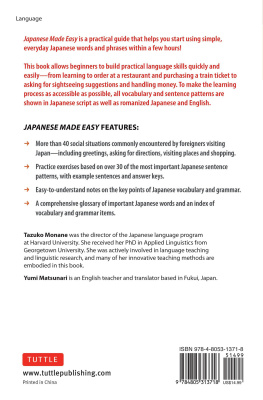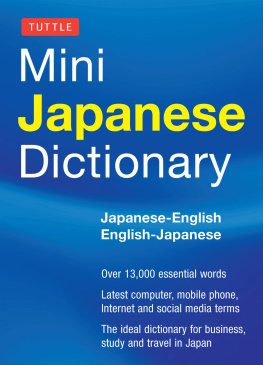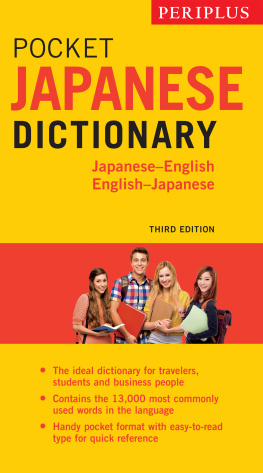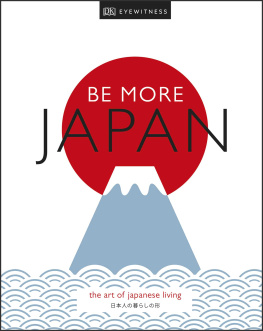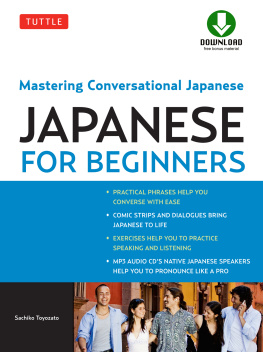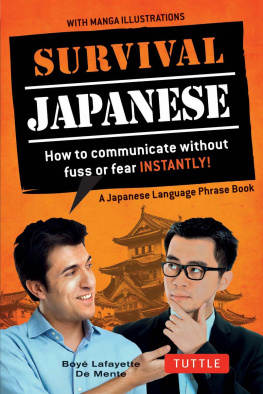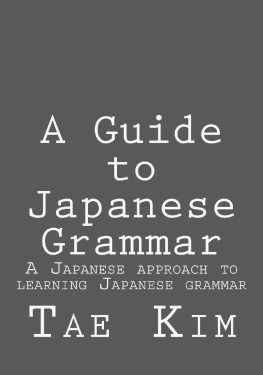A situation-based guide designed to get you speaking simple Japanese from the very first day!
Japanese
Made Easy
Revised and Updated
Tazuko Ajiro Monane
Updated and revised by Yumi Matsunari

ABOUT TUTTLE
Books to Span the East and West
Our core mission at Tuttle Publishing is to create books which bring people together one page at a time. Tuttle was founded in 1832 in the small New England town of Rutland, Vermont (USA). Our fundamental values remain as strong today as they were thento publish best-in-class books informing the English-speaking world about the countries and peoples of Asia. The world has become a smaller place today and Asias economic, cultural and political influence has expanded, yet the need for meaningful dialogue and information about this diverse region has never been greater. Since 1948, Tuttle has been a leader in publishing books on the cultures, arts, cuisines, languages and literatures of Asia. Our authors and photographers have won numerous awards and Tuttle has published thousands of books on subjects ranging from martial arts to paper crafts. We welcome you to explore the wealth of information available on Asia at www.tuttlepublishing.com.
Published by Tuttle Publishing, an imprint of Periplus Editions (HK) Ltd.
www.tuttlepublishing.com
Copyright 2019 by Periplus Editions (HK) Ltd.
Front cover Wayne0216, Shutterstock
All rights reserved. No part of this publication may be reproduced or utilized in any form or by any means, electronic or mechanical, including photocopying, recording, or by any information storage and retrieval system, without prior written permission from the publisher.
Library of Congress Control Number: 2019935466
ISBN: 978-1-4629-0102-9
(Previously published as ISBN: 978-4-8053-0963-6)
Distributed by
North America, Latin America & Europe
Tuttle Publishing
364 Innovation Drive
North Clarendon, VT 05759-9436 U.S.A.
Tel: 1 (802) 773-8930
Fax: 1 (802) 773-6993
www.tuttlepublishing.com
Japan
Tuttle Publishing
Yaekari Building, 3rd Floor
5-4-12 Osaki, Shinagawa-ku
Tokyo 141 0032
Tel: (81) 3 5437-0171
Fax: (81) 3 5437-0755
www.tuttle.co.jp
Asia Pacific
Berkeley Books Pte Ltd
3 Kallang Sector #04-01
Singapore 349278
Tel: (65) 6741 2178
Fax: (65) 6741 2179
www.periplus.com
First revised edition
22 21 20 19 5 4 3 2 1
Printed in China 1908RR
TUTTLE PUBLISHING is a registered trademark of Tuttle Publishing, a division of Periplus Editions (HK) Ltd.
ACKNOWLEDGMENTS
I should like to express my warm thanks most of all to my students, who have taught me the importance of placing in real-life situations each language pattern they learn. Their interest and motivation to learn when language comes situationally alive has been a major inspiration for me in preparing this book.
I am deeply indebted to Mrs Pamela Miller for her help with the initial editing. The ideas, suggestions, and encouragement of my husband, Dr Joseph Monane, have been a constant source of support. Finally, I should like to express my appreciation to the Charles E. Tuttle Company, whose receptivity to the format of this book has been a warm and gratifying experience.
TAZUKO AJIRO MONANE
I would like to thank all the editors and designers at Tuttle Publishing, especially Eric Oey, Bob Graham, Nancy Goh, and Angie Ang, for inviting me to participate in this project and assisting me in my efforts. The core of the late Dr. Tazuko Monanes work is timeless, and is as valuable for todays students as when it was first written. It has been an honor for me to revise the work to reflect current language usage, and I have done my best to do so in a manner that is sensitive to the integrity of the original material. I would also like to thank my sons, James and Luke, for their love and support.
YUMI MATSUNARI
STUDY SUGGESTIONS
Japanese Made Easy is a basic, do-it-yourself guide to the Japanese language and is designed for people living in or going to Japan who have never studied Japanese before. Obviously, living or traveling in Japan is itself not the secret of learning Japanesemany foreigners live in Japan for a long time and except for a few words learn very little about its language. The important thing will be your motivation to learn. Whether you go to Japan as a tourist, student, or businessperson, whether you use this book before or after your arrival in Japan, what could provide better motivation than knowing that a familiarity with the Japanese language (and with the culture it reflects) will help make your stay in Japan much richer and much more interesting.
If you have the good fortune to know a Japanese person, he or she will surely make your learning even easierespecially when you study pronunciation. But dont be discouraged if you have no live model to learn from. By following the simple suggestions given here, you will be able to come out with good, understandable Japanese on your own. Here are some ideas, then, for how you can get the most out of this book.
Chapters and lessons
This book contains ten chapters. Each chapter contains an introduction, dialogue, and several lessons. The introduction provides a brief overview of the sentence patterns that appear in the chapter. The dialogue is a short conversation in standard modern Japanese. It presents examples of sentence pattern usage in the context of everyday Japanese conversations. The dialogue is first presented in native Japanese script, followed by romanized Japanese (romaji) and English. It should be read through quickly at first, and then returned to for review after the chapter lessons have been completed. If possible, practice the dialogues with a friend or native speaker, memorizing them as best you can.
Each chapter contains several lessons, each of which focuses on a situation that you are likely to encounter in Japan. Because the vocabulary, sentence patterns, explanations, and practice sections all work together to present the basics of the Japanese language in the context of a single situation, each lesson should be studied as a complete unit. This introduction of new language patterns within common situations is a basic principle that helps all learners, and it should help you to develop a real feel for the material you study.
As your confidence grows through mastering the basic patterns provided herein, you will discover that the patterns are applicable in many more situations than those covered in the book. Though you should, in the beginning, confine yourself to the material in each lesson, try later on to make up new situations on your own to see if you can handle them in Japanese.
Japanese script versus romaji
Japanese script (a combination of hiragana, katakana, and basic kanji) has been added throughout the new edition of the book. Although reading and writing are not taught herein, it is hoped that the inclusion of Japanese script will be useful to those that have just started learning or are already somewhat familiar with the Japanese writing system. If you already know hiragana and katakana (collectively known as kana), comparing the Japanese and romaji scripts will help you to learn some new kanji at the same time that you are mastering the sentence patterns. If you havent yet learned kana, dont let that slow you down. Stick to the romaji and focus on mastering the sentence patterns for now. Later, you can easily learn the kana and then use the Japanese scripts for review.
Next page
